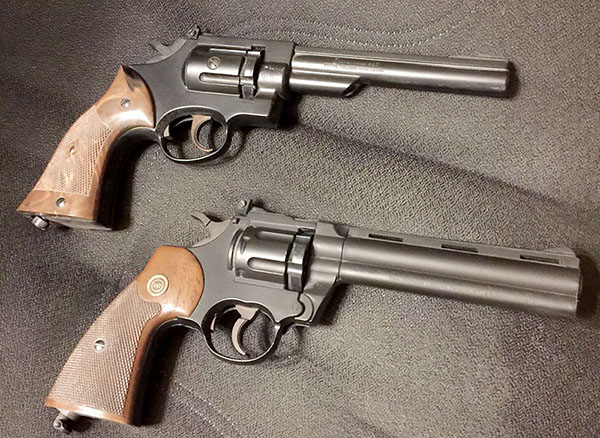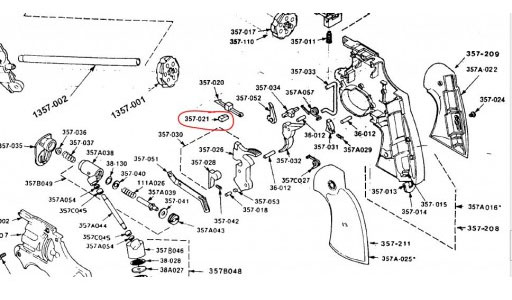Hmmmm….an indoor range with pellet guns during the shelter-in-place. What say you?

Sitting in my home office surfing the net, I’m sheltered in place which basically means staying home. It’s like detention in high school, or maybe house arrest, except if you sneak out you could die. I don’t know what it’s been now. Two weeks? Maybe more? Anyway, I was thinking about how much I missed getting to the range. I’m dry firing my SIG Scorpion a lot and assessing my performance by how stable the sight alignment is when the hammer drops, but it’s not the same thing as seeing the results on target. Then I saw two handguns I hadn’t fired in maybe 30 years. They’re the two you see above…Crosman CO2-powered replicas of a Smith and Wesson Combat Magnum (the Model 19) and the Colt Python. Hmmmm.
So I grabbed the Python and headed out to the garage. You load a CO2 cartridge in these things by popping the left handgrip off, inserting a fresh CO2 cartridge, and then tightening the screw at the bottom of the grip to tap the keg and form a seal. Except it didn’t. Form a seal, that is. Pfffttttt! That’s the sound of a CO2 cartridge emptying. That sound, and a bit of frost on the backstrap due to the rapidly expanding CO2 escaping around what used to be an effective seal.
No problem, I’ll just try the Combat Magnum. It’s good to have spares, you know? Except the results were the same. Pfffffttttt again!
Eternally optimistic, I went back to the Python and took it apart. Cheaply made guts, to be sure, but to my great surprise the internals are more complex than a real Python. Hmmmm. Man, there are a lot of seals inside that thing! I took it all apart and sprayed the hell out of everything with WD40, thinking the seals would be refreshed and, you know, seal. It took a lot longer putting it back together, and then it was another CO2 cartridge. And another frosty Pfffffttttt! Times that by two, and you’ll have a good idea of how I spent Saturday afternoon. Except after the last attempt, I guess I forgot how it all went together again and I reverted to a YouTube video on this specific subject. You can find everything on YouTube. God forbid I ever have a brain tumor, but if I did, I’m pretty sure somebody’s done a YouTube on how to surgically extract it yourself at home using readily-available kitchen utensils.
Sunday morning started with me watching the video again. With the help of a good Mariachi sound track (watch the video) and an artfully-edited YouTube video, I finally got the Crosman back together with no parts left over.
My Crosman .357 had two problems. The first was its Pfffftttt! problem; the other was the “elastomeric spring” that holds the barrel latch up. That part was sort of a rubber chingadera that had degraded and hardened. The spring aspect of its existence didn’t really work because the part no longer had any spring to it. Holding and examining it in my fingers, it fell apart like a cheap politician’s promise (sorry for the redundancy). I thought maybe I could order a new elastomeric spring (which really is an exotic term for a little piece of rubber), but when I went online I saw right away I would have problem. I found parts lists for my pellet pistol, but most of the parts were out of stock, and the few parts that were still in stock were way expensive. I only paid something like $37 when I bought the pellet gun maybe 35 years ago. There’s no way I’m going to pay half that for a little piece of rubber.
Like most exploded drawings, though, it was visually arresting. I was already in mental handcuffs studying it when I noticed the elastomeric spring circled in red. Whoever loaded that drawing evidently needed the same part.

The way the Crosman 357 loads is you depress a button in the top of the frame and it acts against the elastomeric spring you see in the drawing above. That lowers a lever to unlock a tab (the lever is the part immediately above the elastomeric spring in the drawing). That allows you to unlock and rotate the barrel down and the gun opens like an old British Webley. Then you can remove the cylinder and put the pellets in it.
I couldn’t fix the seal problem, but I felt like I wanted to fix something. So I cut up a wide rubber band, superglued the pieces together, and made my own elastomeric spring. It works well. But that’s not the main problem. That honor goes to the seals being (pardon the pun) shot. They are suffering (like me) from age-induced degradation. To make a long story longer, I went through six CO2 cartridges trying to find a fix. You can buy new seals, but they cost nearly as much as what I paid for the whole gun originally. And that’s before you put the larcenous shipping and handling charges on top of it all. Truth be told, I just don’t want to mess with the Crosman anymore. Even if I got those new seals, there’s no guarantee the thing is going to work.
The good news? I know a hell of a lot more about how a Crosman pellet revolver is supposed to work. More good news? The story I’m telling here was an interesting way to spend eight hours of my shelter in place time. The bad news? My two Crosman pellet guns are now nothing more than display pieces. I could probably find a way to make new seals, but I’m just not that committed to it.
I’ve got another CO2 pellet gun (a 1911) laying around somewhere that I’ve had about 10 years and never fired. I might dig it out later and screw around with it. I’ve also got an old Daisy pneumatic pellet pistol, and I think I’ll try to find it to see if it still works. As always, stay tuned.

Have you ever written about the air rifle that was carried by Lewis and Clark on their expedition?
I bet that’s an interesting story!
Nobody tells stories about mechanical things better than you!
Carlos
Carl, I mentioned it in the last paragraph of a book review here on the blog about Undaunted Courage, the story of the Lewis and Clark expedition that you can read here. I believe some of the comments posted to that review mention it further. I was surprised the technology existed way back then.
Joe — Own an air pistol and learn about seals. The two go together. I have an S&W air pistol that had aged, ineffective seals. I sent it to a fellow in Victorville and he fixed it up like new. No, I don’t remember what it cost. I strongly suspect that now with the passage of time, his replacement seals are no longer doing the job. If I had more energy, I would get it out and see if it’s shootable. Good luck.
Thanks, Marty. I’d like to see that S&W someday.
Exhaustnotes group buy on P-17’s!
That would be fun!
FYI, here’s the P17 Joe mentions: P17 Beeman
Cheap politicians. Redundant. Heh, heh, heh …